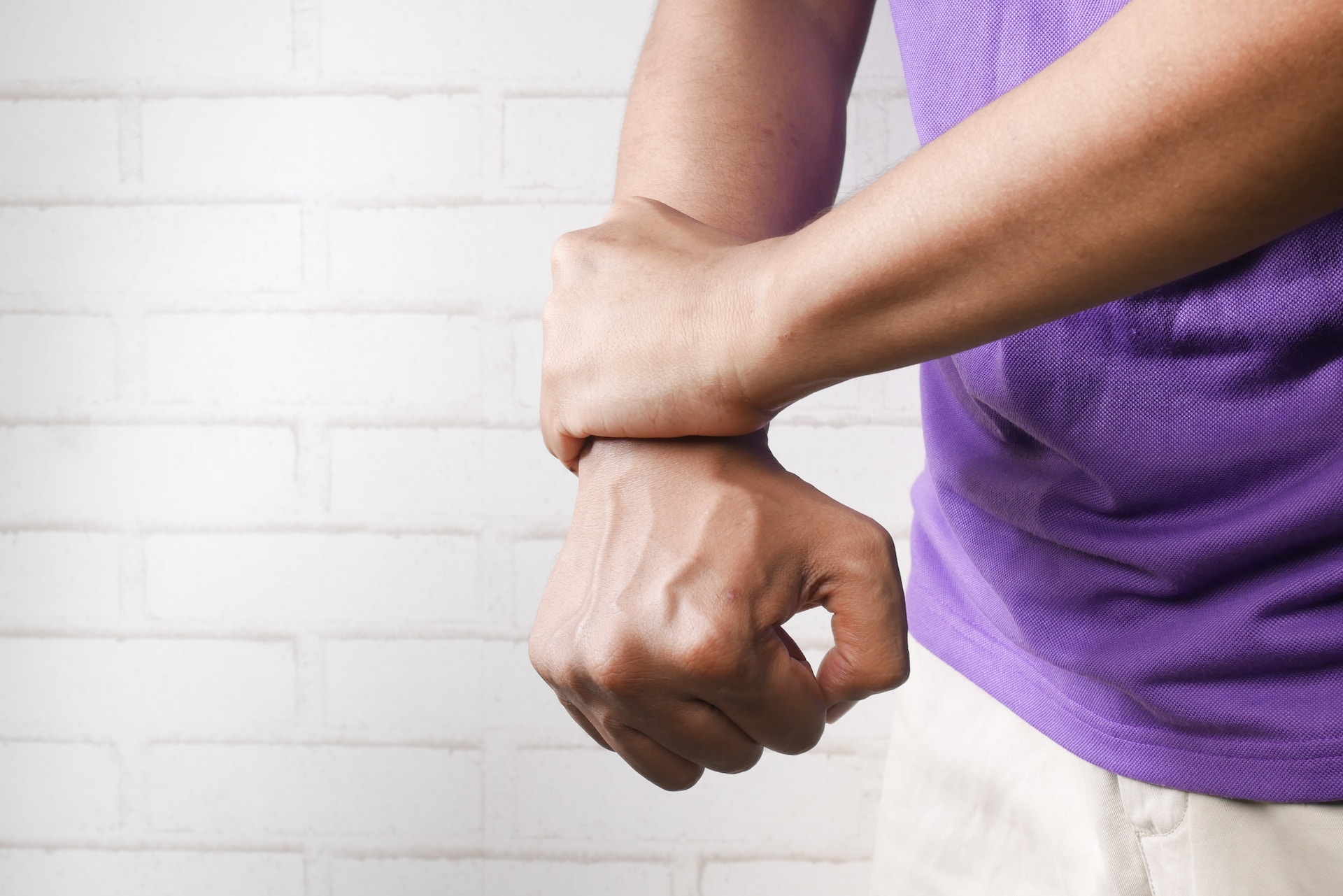There are always occupational hazards with virtually any hobby or job. If you’ve been playing for a little while and you find that you are getting wrist pain from piano, it isn’t always cause for concern. There are plenty of things that you may be able to do to ease the wrist pain. You may also be able to stop it altogether.
It can be really frustrating. Whether the pain starts while you are playing piano or comes on later, you will probably be concerned. In this guide, we’re showing you some of the reasons why piano wrist pain can happen as well as some steps for prevention, and what you should do for treatment.
Of course, we’re all about piano technique and we aren’t doctors. If you are in any severe pain or you are worried, consult a qualified physician. Never take any chances with your health.
Is Wrist Pain Inevitable?
Let’s start by saying that wrist pain from piano is not inevitable. Sometimes it comes from poor technique, sometimes it comes from overdoing things. For some people, piano will give their hands and wrists a bit of a workout but never cause any real pain.
So, it isn’t a “right of passage” to go through. Wrist pain is something you should always look to address if it crops up.
It is also possible that your wrist pain isn’t actually stemming from playing piano. Perhaps you’ve picked up an injury elsewhere from playing sports, for instance. The piano wrist pain could just be a result of other injuries.
The best way to avoid it ever becoming a problem is to make sure that you are learning the right technique. When you start out with lessons such as the Pianu Academy, you should spend some time focusing on this. Learn how your hands should be positioned and how you can take the strain off your joints while you play.
Why Piano Causes Wrist Pain
This is actually a little misleading. Piano doesn’t inherently cause wrist pain, it will stem from something related to playing the piano.
Common complications include:
- Developing Carpal Tunnel Syndrome (more on this later).
- Poor technique. This is usually the cause of any pain you get from playing the piano. Your technique might be slightly off, especially if you have not learned from a reliable source.
- Overdoing it. If you are playing piano all day every day then there is a chance that any small issues with your technique will be exacerbated and cause pain.
Some people are unfortunate and already have some issues with pain, such as joint and wrist pain that can cause a lot of complications. Other people develop the issues by not playing piano in a way that is suitable.
It is further complicated by the fact that there isn’t necessarily one technique that works for playing the piano. There are a few different approaches, as we will cover later in this guide.
Carpal Tunnel Syndrome
Once again, it is a good time to reiterate that you should go to the doctor with any serious medical issues.
Carpal Tunnel Syndrome is fairly common among pianists. This condition comes from pressure on a nerve within your wrist which can cause numbness and pain within your wrist. In fact, the pain can be anywhere between your fingertips and up your arm.
The symptoms include tingling and numbness as well as pain, and this can make it very difficult to play piano. If your technique is poor or you are unfortunate and have the condition for another reason it may need treatment.
It is called Carpal Tunnel Syndrome because of the carpal tunnel we have within the wrist. This can inflame and swell, squeezing the nerve within your wrist and causing all of the complications.
This excellent video gives you an overview of what the syndrome is and how it tends to happen. As you can see from this, it is very possible that you can get complications from CTS. You should definitely take pain and tingling very seriously.
You might find that you are more susceptible than some. For example, if you have a job where you are using your hands or wrists all day then you might be more prone to wrist problems from piano.
Luckily, there are things you can do for CTS and any other type of wrist pain.
Don’t Overdo It
The simplest tip we can give. Don’t overdo your playing, especially when you are starting out. Some of us get tempted to play piano for hours on end. It can feel great when you sign up for Pianu Academy and start to learn songs you already know and love. 30 minutes practice per day is often enough, though.
In fact, if you play for hours on end it can become difficult to absorb the knowledge anyway. Shorter, bite-sized lessons are often the best way to learn.
Set yourself a timer and be strict with it. It is good for your brain and for your body. Even if your technique is slightly off it shouldn’t cause too many issues. Who has perfect technique to start with anyway?
If you are feeling pain then don’t try to push through. This will only make it worse. If you do have Carpal Tunnel Syndrome then you will find that the swelling will get worse if you don’t stop.
Learning the Correct Piano Technique
It is one thing to learn the notes and what they mean and other aspects of the keyboard, but you need to have the right technique.
Unfortunately, as with a lot of different elements of the piano, there is some debate over the correct technique.
Josh Wright has created a great video below. He explains a lot of the key information, and also the fact that it is slightly different for everyone. There are different “schools” of tuition. However, a lot of the basics should always be the same, such as where your hands and elbows sit in relation to the piano.
The arm, the wrist, and the fingers are the key. You need to avoid a jabbing motion from above. Josh shows us what children tend to play like when they first experiment and how you can relax into playing. He has a really bouncy technique, which definitely works for him, but different people have slight variations and different techniques for different styles.
When you are self-teaching piano, it is important to understand the fundamentals. Watch carefully how others are playing. When you watch tutorial videos it is a good idea to work out what is going on with the hands and the wrist. Ensure you are getting the maximum span across the piano and that you follow a solid method of doing things, even though there are different varieties in approach.
Prepare Properly and Relax The Hands
The German approach to playing has a lot of focus on preparing your hands and getting them in the right position for playing. This helps you to play close to the keys and ensure that you don’t have your hands in a position that puts extra pressure on.
The important thing is that you need to regularly relax the hand. A lot of the problems come from the fact that there is a lot of tension in the hands.
So, let’s say you are running through one of the lessons in Pianu, and you want to perfect a scale or song. It is tempting to just keep playing through it time after time. Even between play throughs it is possible that your hands don’t properly relax. Having your hands in an unnatural, tense position for all of this time can give you a lot of complications. This is how things like Carpal Tunnel Syndrome can start.
So, when it comes to relaxing, make sure that you don’t spend your whole lesson with your hands tense and ready to play. Relax them from time to time. This might mean letting them dangle down by your body. Some people might find it easier to get up and do something normal. Go and get a drink and take a couple of minutes to yourself. Your hands are more likely to properly relax if you are doing something you find natural.
You might see a pianist shake their hands between playing or do something similar. This is likely to be because they are releasing all the tension. If you have a job where you type a lot or operate manual machinery with your hands, it is possible that you will have even more need to relax your hands.
Wrists Should Not Bend or Tilt
Your wrists can rotate, and your forearms need to move around to help you to reach the notes. You will also learn that your thumb will cross over as you explore the notes.
However, your wrists shouldn’t move that much, and shouldn’t bend or tilt too much. A lot of piano teachers will put an item on top of the wrist, with the theory being that you should be able to keep it on the top of your wrist while playing. Even when your thumb crosses under the wrist should be pretty straight. A small item should stay in place.
If you are reaching with your hands and your pinky fingers feel like they are having to stretch then you might be putting undue pressure on. Your wrist shouldn’t take the strain and if it does, wrist pain from piano playing is almost inevitable.
Your Elbows Should Be Below the Keys
This is something that it is super easy to check. It is not always easy to address as your body might not help you here, but if you have an adjustable bench it can be easier to tweak.
Most people who are first learning piano either sit too high up or too low underneath the piano. It is all about working out your body type. Do you have longer legs and a short body or the other way around?
The elbows need to be slightly underneath the level of the keys. The most effective way of avoiding wrist pain from piano is to keep the hands, arm, and wrists in a relatively straight line. If your wrist is too high so it feels like you are jabbing down on the keys, or if your wrist is much too low so you are reaching up, you will get pain. Adjustable benches are your friends!
It is a bit like when you drive a car and you need to adjust the height so that you are comfortable and in control. Aligning your body so that you are in the best position is a huge help.
If you play standing up, for instance if you’re playing a keyboard or digital piano, it is possible to still get the ideal angle by tilting the keyboard. You may also be able to adjust the stand.
Posture at the piano is utterly crucial. It can be hard to totally understand in words, but the video below helps you to understand how to sit at the piano correctly. This avoids putting strain on various parts of your body. Your wrists certainly shouldn’t be doing a great deal of the work.
Ensure that your feet are rested perfectly on the floor, or even a stool if they don’t reach. Sit upright and don’t slough into your piano playing. This can lead to all sorts of different problems.
Your elbows should be perfectly by your sides, not splayed out. One way to remember this is that you want to avoid “chicken wings” which is how it can look when your arms extend outwards.
It can take a little time to get these fundamentals right but it is definitely worth investing that time. Learning with poor technique can be even harder to correct when you get further down the line.
Play Fast, But in Clusters
This sounds like confusing advice to avoid wrist pain from piano, but let us explain. Some people learn to play things slowly first and gradually introduce speed. This is fine if you don’t experience tension and pain, but if you do, then there may be some downsides.
When you play slowly you often carry a lot of tension. Your hands aren’t gliding across the keys playing the notes. This means that even when you speed up your playing having learned properly you might end up with some bad habits. These might mean you carry all that tension into your playing.
Instead, try learning at the speed of the actual piece of music, but in very small chunks. You may learn a bar at a time, or a couple of bars. This means you’re breaking down the piano playing but still playing quickly.
Gravity is Your Friend
A lot of people refer to letting gravity do the work. If your hands are in the right position then gravity can certainly help. It is almost like letting your hands fall into the right position.
This is quite an abstract concept if you haven’t played before, but it will click for you one day. It should be effortless and pain-free to run through a song.
You are effectively using the weight of your arm to play rather than relying on any sort of pressing motion. If you feel that you are physically pressing down on the keys with your hand, there is probably a problem with your technique.
Should You Have a Lesson In-Person?
It isn’t necessary to have lessons in person. This is one of the most amazing things about learning how to play piano in the modern age. With Pianu, you can sign up for our lessons and learn from the comfort of your home. No scheduling lessons, no worries about having to get there. You can even learn in your pajamas.
If you do find that you are getting some wrist pain, consider the cause. Is it likely to be purely from piano or is it that you have a job that puts extra strain on your hands and wrists?
Perfecting your technique should be the focus. If you really can’t get this right from videos then there is no harm in having a couple of lessons. A good tutor will be able to help you to get your posture correct and avoid wrist pain from piano. Most people can get there on their own, but there’s no harm in a good teacher in person, especially when you get to a more advanced level.
What to Do If You Get Wrist Pain
So, if you are getting pains in your wrist after or during playing piano, what are you able to do about it? As with all ailments and health issues this is not something to ignore. If you have pain then it could get worse if you don’t deal with it.
See a Doctor
I know, we keep reiterating this, but it really is crucial. Nobody can diagnose you fully without knowing the specific symptoms you have. While it could be some simple joint pain from overdoing things it could be something more serious. You need to rule out this possibility. Issues like arthritis can be really debilitating so don’t take any chances at all.
Carpal Tunnel Syndrome Treatments
If you have CTS, there are a number of different treatments you can turn to. Even if you aren’t certain that this is the cause, there are some exercises and even products that you can use to try and treat the wrist pain from piano.
Wrist Splints
Wrist splints may help to keep your wrists straight. They aren’t great to play piano with, but you don’t have to wear them 24/7. A lot of people just wear them at night, which can help to keep the wrist positioned properly even while you’re sleeping.
Surgery
It may sound extreme, but the surgery is not actually that invasive and can be recovered from in a relatively short time. It has a huge success rate, too. Of course there are some risks involved and it doesn’t work for everybody. The process effectively opens up the carpal tunnel which takes pressure off of the median nerve which is what is causing the pain, tingling, and other symptoms.
Steroid Injections
Some people find that steroid injections can work. However, they may have diminishing returns. It is unlikely that they will work for years and years, so if you are struggling then you might need a different long-term solution.
Exercises
There are many different exercises that you can do to try and help. These may build strength in the arms or certain areas of the hand and generally take the pressure off your wrists.
The video below talks you through three of the very best exercises that can help to relieve the pain. They can also help you to avoid the issues cropping up again in the future.
Some people also swear by things like yoga, which can be a great way to alleviate pressure. There may be a range of treatments that work for you, and if things become painful there are painkillers that can be used. However, make sure you stick to the instructions and don’t overdo it.
Summary
When you are learning the piano online there are so many different advantages, but sometimes you will have to pay extra attention. This includes when you are working out how to sit at the piano, and how your hands and wrists should be used.
Watching some videos (some great examples are in this guide) and checking out other material in addition to following the exercises in the Pianu Academy will help you to get the right technique and avoid pain from becoming an issue. Nobody wants to experience pain as a result of their hobby, and with the right technique you can avoid this altogether.
If you do find that the pain is becoming an issue, consult with medical professionals. On top of this, you can try numerous options like splints and exercises to keep your wrists strong and pain-free.














